#flowchart software
Explore tagged Tumblr posts
Text
Draw.io for Windows
Draw.io is a powerful and intuitive diagramming tool designed to help professionals, students, and hobbyists create a variety of diagrams with ease. Whether you’re preparing detailed workflows, creating flowcharts, or developing organizational charts, this free software caters to all your needs. Its simple and user-friendly interface, combined with robust features, makes it a standout choice for…
#collaboration tool#create diagrams#diagram maker#Draw.io for Windows#flowchart software#free diagram tool#open-source diagramming#UML tool
0 notes
Text
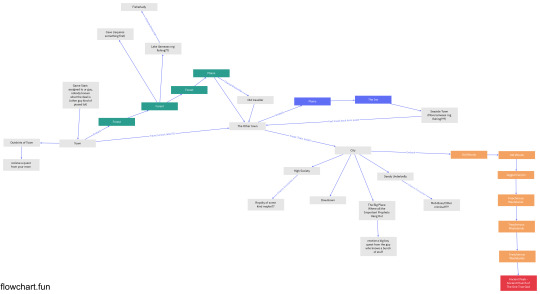
oh no it seems like I'm using my limited time on this earth to start planning an overly complicated choose-your-own-adventure style video game!! somebody stop me!!! agghhhh!!
#also uhm.... flowchart.fun is nice enough but if anyone knows abt some other free software/online thing to make flowcharts lmk#it keeps doing this weird thing where whenever i add a new branch it moves everything around and it SUCKS!! also saving my progress is weir#so yea
3 notes
·
View notes
Text
Flowchart of for loop in C
Let us see the flowchart of for loop in C:
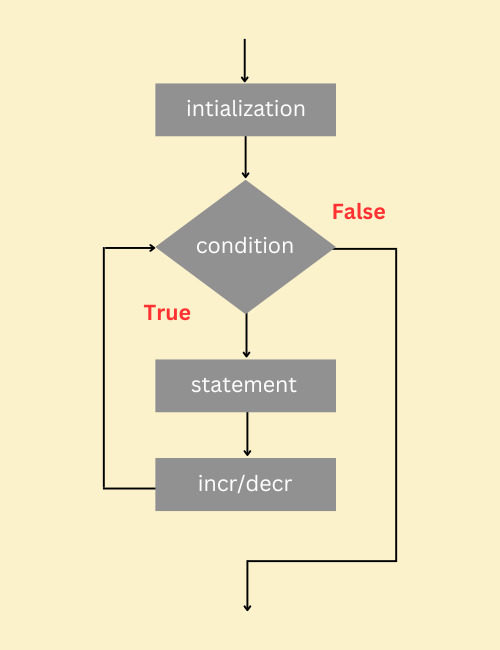
#c#programming#cprogramming#code#coding#engineering#software#softwaredevelopment#education#technology#flowchart#forloop#loop#loopinc#forloopinc#online
3 notes
·
View notes
Text
0 notes
Text
tumblr help a bird out.
I need like a good flowchart/webchart maker that doesn't have ai. I wanna make something really dumb but every flowchart software i see has some kind of ai thing and I don't fuck with that.
0 notes
Text
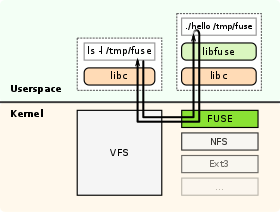
1 note
·
View note
Text
Which Software Is Ideal for Creating Flowcharts?
Using intuitive graphics can help individuals and teams communicate and reach decisions more quickly. The ability to handle sophisticated logic, replication, and modifications/alterations is one of flowcharts' primary constraints. Business users need the best flowcharting software to simplify and make the process interesting. After determining the most crucial specifications, look at the top software for 2023.
Business process automation
In order to manage duplicate operations in a corporation, automation is essential. Business rules engines with AI capabilities can be used by businesses to implement automated decision-making. Software users don't need to be trained in coding to visualize business logic. An organization can increase its consistency and clarity by implementing automation technology for decisions, workflows, and intelligence.
An online client survey and chatbot
When responding to online queries, a chatbot can efficiently manage several users at once. It is easier to arrange information, illustrate the decision-making process, and provide a solution as an equation for addressing a problem when a decision flowchart is used in the background to streamline complex situations. The software used to create flowcharts should therefore include in software for making flowcharts.
Document automation
Can a document be automatically generated by software following a session? Any company looking to grow quickly will benefit from having a strong software solution that can generate decision making diagrams, decision flowcharts, conversational chatbots, end-user questionnaires, and output papers.
With the help of VisiRule, a potent no-code low-code AI software suite, business people without programming experience may create solutions. Because it meets all of the above requirements, the flexible tool is the finest program for making flowcharts.
0 notes
Text
Writing Tools for Planning Your Story
I've tried tons of writing apps and sites, so you don't have to. Here's a list of free sites to plot out your novel, with my review and some images of how I use it.
Milanote
Milanote is like having a giant pinboard with folders. You can upload anything onto it [yes even your main doc] and then draw over it or connect things with lines and arrows
Milanote lets you add up to a hundred things for free, not including drawing. This is one of the downsides of the site as I've found myself reaching that limit recently.
For me, the best part is being able to draw over stuff, and the color swatches.
Milanote is a lot less structured than other sites I've used, and personally, I don't think their templates are worth using.
8/10 overall, Milanote is what I mainly use. Here are some pics of how I use it:
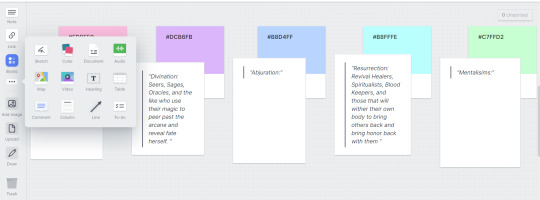
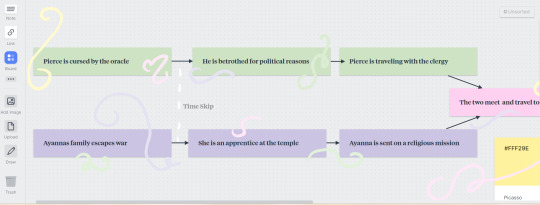
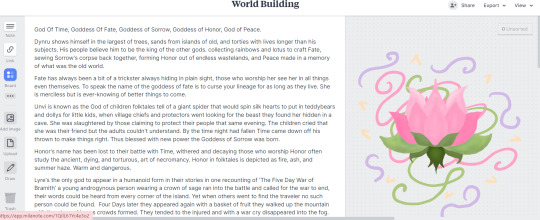
Miro
Miro is a flowchart website mainly used for corporate jobs, however, it can be a great plotting tool for that reason
Miro has a lot of great starter templates if you are looking for a more structured freeform experience. It also comes with a blank page as well.
Unfortunately, I'd argue that it's a bit of a hard tool for beginners to use without a template, I've learned copy-paste is my best friend with Miro the hard way.
It's much better than most platforms at making timelines though.
It has a limit of three boards which is a bit disappointing but overall, I think it's worth the try.
5/10 Miro is very middle of the road for me due to the limited ability to customize things and the free limit. Here are some pics:
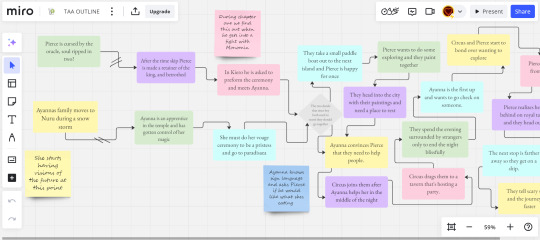
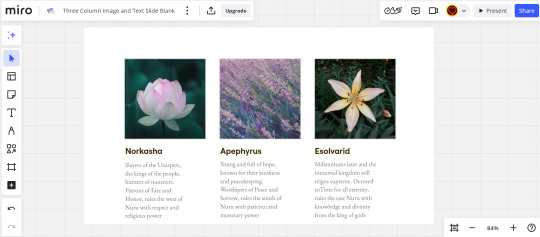
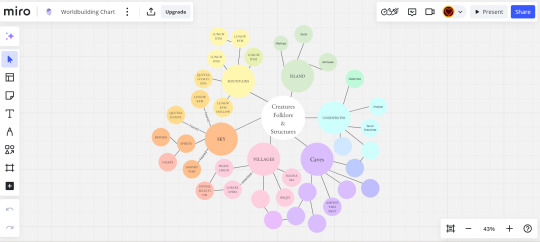
[I wrote that part weeks ago, I am now fully using Miro and believe it's the best for making timelines and charts, I just wish it let me make more boards 8/10]
Hiveword
This might be someone's jam, I can't really say it's mine though.
First off, the unpaid version is really just a few boxes saying "Write a summary here." which makes it just not worth it in my opinion
There really isn't any way to customise things which is my favorite part of most of these softwares
I've barely used this, so maybe there's something I'm missing but
1/10, Just use Google Docs at this point, here's a couple pics
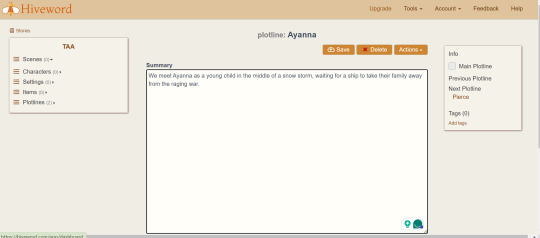

World Anvil
People like this software, it's mainly used for tabletop, which is just a different way of writing adventure, and I've seen it recommended by authors.
Unfortunately, I'm going to disagree with a lot of people and say it's hard to use and isn't even really good at plotting.
I may be biased on this one as every time I've tried to use it in the past I've struggled. However, it seems like another just write it in a document and create a folder.
I'd say it's closer to an organizing tool, but even then just use something else.
3/10, I have nothing to say about it but maybe you'll enjoy it, all here are two photos
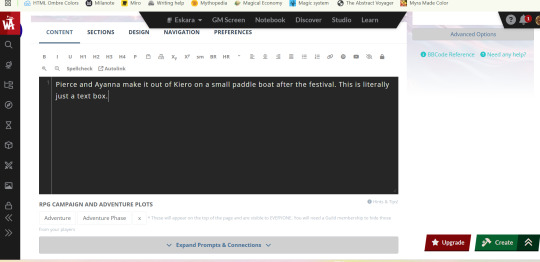

Campfire
This is the one I think I've heard the most about, but have never actually tried.
right off the bat, I'm going to say this is 100% worth it, you'll see at the end with the photos but this is like if Miro and World Anvil had an organization baby.
It's extremely easy to understand, and it makes timelines, it's more for writing your whole book but idk about that yet.
7/10, its themes are really pretty but it limits how much you can do to 20 I believe. Here are the photos
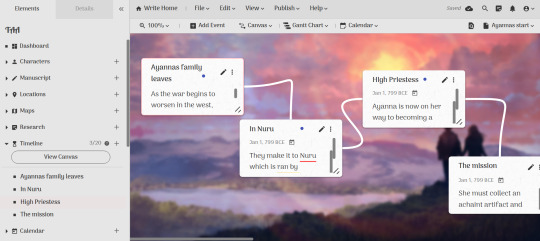
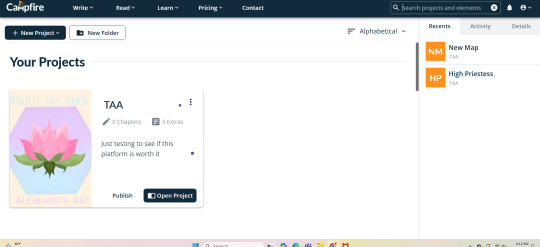
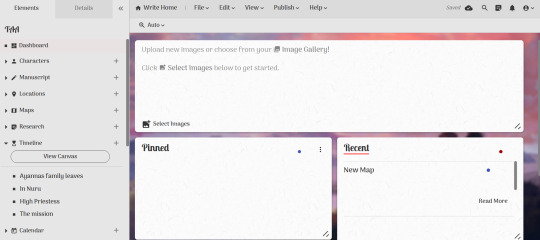
That's all for now, honestly, I think you should use Miro if you are looking to plot things out, and Milanote if you want to collect and organize your thoughts for writing, as that's what I do. Obviously what I like won't be for everyone, but hopefully, this helped you see some options
#writeblr#writers on tumblr#creative writing#worldbuilding#plotting#writing advice#writing tool#writing#writers#writing plans
1K notes
·
View notes
Text
Decrypting the morse code in the new QSMP teaser (a detailed explanation)
Quackity's new teaser for QSMP 2 (or something??) contained a long sequence of morse code which I... spent like 6 hours decrypting, and this is an explanation of how I did it (and you can, too, shall you wish to!)
I also posted a shorter analysis on my blog where I looked at all the different aspects of the video (the spoken words, the words flashing on the screen AND the morse code) in case you wanna learn more about the video in general.
The only program I used for this was audacity, which is free and which you can download quite easily.
Getting the audio ready
First, I recorded the audio by playing the video in one tab and recording it via Audacity in another using a tutorial here. Before that, I tried to use VLC, but it has a bug that makes it so it will only record the video and not the audio. Still, useful if you only want the video!
After I had the audio of the whole video, I needed to extract the morse code since in some sequences, it would be literally impossible (at least for me, dunno about you superhuman) to understand the morse code due to all the background noise. To do this, I first looked at a sequence where there was ONLY the morse code and nothing else and analyzed the spectrum of this.
This 'spectrum' is essentially just a graph of how much sound of a certain frequency (measured in Hz) is in a certain snippet that I selected.

The top is the frequency of the morse code, so the plan is to keep this frequency (469 Hz) and throw everything else out.
In order to do this, I used the menus which you can find in audacity under 'effects -> Dominic Mazzoni,' reduced the volume of everything above 480 Hz by 48 Db (there is an option for how much you want to reduce it, but seeing as we don't need it at all we might as well reduce it as much as possible) and same for everything below 460.
After cutting it, I was left with a recording of (mostly) only the morse code.
Decoding the morse code
Of course, I tried to do it the lazy way and punched the thing into a software which is supposed to be able to get morse code from recordings, CwGet. Did not work though, the thing is like REALLY old so I'd recommend searching another one. The only thing it DID grab correctly was 'is sacred im coming' but besides that it was just... bs.
SO, I had to do it myself.
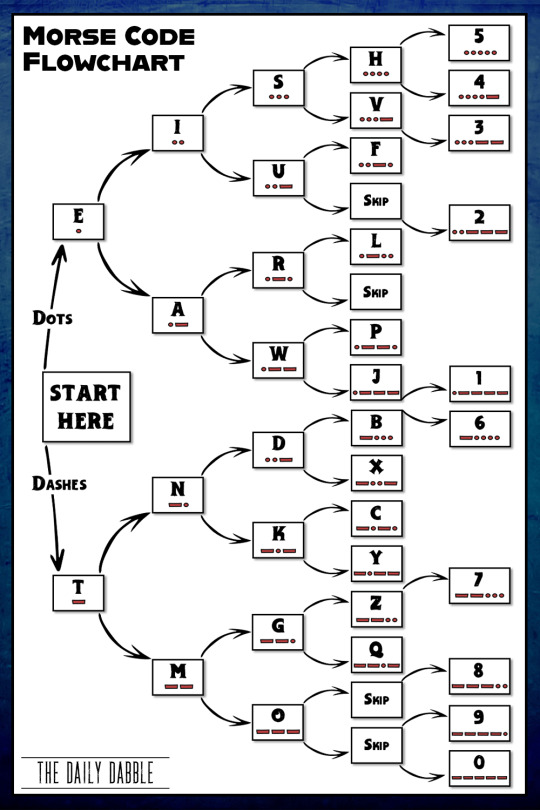
(the best flowchart for morse code I was able to find)
Now, I won't bore you with all of the stuff where I wasn't sure about something and had to go over it over and over again, but one thing I do want to mention is that, in a very specific part, I did the filtering thing again, this time with 465 and 475 Hz though, and got an even cleaner result out of that. BUT, the more you do that the quieter the whole thing gets so I had to crank up the volume everywhere all the way. You hear it more clearly but it's quieter.
The following is, of course, not completely guaranteed to be true, but it sounds like the most logical one to me. IMSORRY .. -- ... --- .-. .-. -.-- IMSORRY .. -- ... --- .-. .-. -.-- IMSORRY .. -- ... --- .-. .-. -.-- PLEASEHELP .--. .-.. . .- ... . .... . .-.. .--. HELPHELP .... . .-.. .--. .... . .-.. .--. SOSSOSSOS ... --- ... ... --- ... ... --- ... ITSNOTREAL .. - ... -. --- - .-. . .- .-.. ITSNOTPOSSIBLE .. - ... -. --- - .--. --- ... ... .. -... .-.. . TOHAVETHIS - --- .... .- ...- . - .... .. ... YOUAREMEANT -.-- --- .-- .- .-. . -- . .- -. - FORTHISYOU ..-. --- .-. - .... .. ... -.-- --- ..- AREMEANT .- .-. . -- . .- -. - FORTHISYOU ..-. --- .-. - .... .- ... -.-- --- ..- AREMEANT .- .-. . -- . .- -. -
1:27 in the recording RETURNTOYOUR .-. . - ..- .-. -. - --- -.-- --- ..- .-. Still unresolved what the following could mean (different versions): ORIEFIRL --- .-. .. . ..-. .. .-. .-.. ORIFISL --- .-. .. ..-. .. ... .-..
And also still unresolved but I only have one version for this: GFBEYAMMD --. ..-. -... . -.-- .- -- -- -..
THATWALL - .... .- - .-- .- .-.. .-.. ITISCURSED .. ... -.-. ..- ..-. ... . -.. ITISSACRED .. - .. ... ... .- -.-. .-. . -.. IMCOMING .. -- -.-. --- -- .. -. --. BAC -... .- -.-. I still haven't been able to find the missing k 'back' technically has, it is possible it comes WAYYYY later and so I don't have it in my recording, but I think the message is clear enough.
There are still passages where I am completely unsure what they mean. It could be me not understanding it correctly, but the rest has been fairly easy so I don't know about that. It could also be encrypted or just complete bullshit. Either way, if you want to give it a try and see if you can make something of it, please feel free to give it a listen!
The complete text reads as:
I'm sorry, I'm sorry, I'm sorry please help, help, help SOS SOS SOS It's not real, it's not possible to have this You are meant for this You are meant for this You are meant [to] return to your (ORIEFIRLGFBEYAMMD/ORIFISLGFBEYAMMD (yes no idea either)) That wall, it is cursed It is sacred I'm coming bac[k].
brackets [ ] where there should be something in order for it to make sense but there isn't.
29 notes
·
View notes
Text
Uh.
So.
I just reached the maximum number of shapes in the flowchart software I was using to diagram the Summers Family Tree.
Fuck.
23 notes
·
View notes
Note
Please tell us how to get into IT without a degree! I have an interview for a small tech company this week and I’m going in as admin but as things expand I can bootstrap into a better role and I’d really appreciate knowing what skills are likely to be crucial for making that pivot.
Absolutely!! You'd be in a great position to switch to IT, since as an admin, you'd already have some familiarity with the systems and with the workplace in general. Moving between roles is easier in a smaller workplace, too.
So, this is a semi-brief guide to getting an entry-level position, for someone with zero IT experience. That position is almost always going to be help desk. You've probably heard a lot of shit about help desk, but I've always enjoyed it.
So, here we go! How to get into IT for beginners!
The most important thing on your resume will be
✨~🌟Certifications!!🌟~✨
Studying for certs can teach you a lot, especially if you're entirely new to the field. But they're also really important for getting interviews. Lots of jobs will require a cert or degree, and even if you have 5 years of experience doing exactly what the job description is, without one of those the ATS will shunt your resume into a black hole and neither HR or the IT manager will see it.
First, I recommend getting the CompTIA A+. This will teach you the basics of how the parts of a computer work together - hardware, software, how networking works, how operating systems work, troubleshooting skills, etc. If you don't have a specific area of IT you're interested in, this is REQUIRED. Even if you do, I suggest you get this cert just to get your foot in the door.
I recommend the CompTIA certs in general. They'll give you a good baseline and look good on your resume. I only got the A+ and the Network+, so can't speak for the other exams, but they weren't too tough.
If you're more into development or cybersecurity, check out these roadmaps. You'll still benefit from working help desk while pursuing one of those career paths.
The next most important thing is
🔥🔥Customer service & soft skills🔥🔥
Sorry about that.
I was hired for my first ever IT role on the strength of my interview. I definitely wasn't the only candidate with an A+, but I was the only one who knew how to handle customers (aka end-users). Which is, basically, be polite, make the end-user feel listened to, and don't make them feel stupid. It is ASTOUNDING how many IT people can't do that. I've worked with so many IT people who couldn't hide their scorn or impatience when dealing with non-tech-savvy coworkers.
Please note that you don't need to be a social butterfly or even that socially adept. I'm autistic and learned all my social skills by rote (I literally have flowcharts for social interactions), and I was still exceptional by IT standards.
Third thing, which is more for you than for your resume (although it helps):
🎇Do your own projects🎇
This is both the most and least important thing you can do for your IT career. Least important because this will have the smallest impact on your resume. Most important because this will help you learn (and figure out if IT is actually what you want to do).
The certs and interview might get you a job, but when it comes to doing your job well, hands-on experience is absolutely essential. Here are a few ideas for the complete beginner. Resources linked at the bottom.
Start using the command line. This is called Terminal on Mac and Linux. Use it for things as simple as navigating through file directories, opening apps, testing your connection, that kind of thing. The goal is to get used to using the command line, because you will use it professionally.
Build your own PC. This may sound really intimidating, but I swear it's easy! This is going to be cheaper than buying a prebuilt tower or gaming PC, and you'll learn a ton in the bargain.
Repair old PCs. If you don't want to or can't afford to build your own PC, look for cheap computers on Craiglist, secondhand stores, or elsewhere. I know a lot of universities will sell old technology for cheap. Try to buy a few and make a functioning computer out of parts, or just get one so you can feel comfortable working in the guts of a PC.
Learn Powershell or shell scripting. If you're comfortable with the command line already or just want to jump in the deep end, use scripts to automate tasks on your PC. I found this harder to do for myself than for work, because I mostly use my computer for web browsing. However, there are tons of projects out there for you to try!
Play around with a Raspberry Pi. These are mini-computers ranging from $15-$150+ and are great to experiment with. I've made a media server and a Pi hole (network-wide ad blocking) which were both fun and not too tough. If you're into torrenting, try making a seedbox!
Install Linux on your primary computer. I know, I know - I'm one of those people. But seriously, nothing will teach you more quickly than having to compile drivers through the command line so your Bluetooth headphones will work. Warning: this gets really annoying if you just want your computer to work. Dual-booting is advised.
If this sounds intimidating, that's totally normal. It is intimidating! You're going to have to do a ton of troubleshooting and things will almost never work properly on your first few projects. That is part of the fun!
Resources
Resources I've tried and liked are marked with an asterisk*
Professor Messor's Free A+ Training Course*
PC Building Simulator 2 (video game)
How to build a PC (video)
PC Part Picker (website)*
CompTIA A+ courses on Udemy
50 Basic Windows Commands with Examples*
Mac Terminal Commands Cheat Sheet
Powershell in a Month of Lunches (video series)
Getting Started with Linux (tutorial)* Note: this site is my favorite Linux resource, I highly recommend it.
Getting Started with Raspberry Pi
Raspberry Pi Projects for Beginners
/r/ITCareerQuestions*
Ask A Manager (advice blog on workplace etiquette and more)*
Reddit is helpful for tech questions in general. I have some other resources that involve sailing the seas; feel free to DM me or send an ask I can answer privately.
Tips
DO NOT work at an MSP. That stands for Managed Service Provider, and it's basically an IT department which companies contract to provide tech services. I recommend staying away from them. It's way better to work in an IT department where the end users are your coworkers, not your customers.
DO NOT trust remote entry-level IT jobs. At entry level, part of your job is schlepping around hardware and fixing PCs. A fully-remote position will almost definitely be a call center.
DO write a cover letter. YMMV on this, but every employer I've had has mentioned my cover letter as a reason to hire me.
DO ask your employer to pay for your certs. This applies only to people who either plan to move into IT in the same company, or are already in IT but want more certs.
DO NOT work anywhere without at least one woman in the department. My litmus test is two women, actually, but YMMV. If there is no woman in the department in 2024, and the department is more than 5 people, there is a reason why no women work there.
DO have patience with yourself and keep an open mind! Maybe this is just me, but if I can't do something right the first time, or if I don't love it right away, I get very discouraged. Remember that making mistakes is part of the process, and that IT is a huge field which ranges from UX design to hardware repair. There are tons of directions to go once you've got a little experience!
Disclaimer: this is based on my experience in my area of the US. Things may be different elsewhere, esp. outside of the US.
I hope this is helpful! Let me know if you have more questions!
46 notes
·
View notes
Text
Not sure where to ask this, so im posting here as well as some forums BUT:
Basically I really love using Figma for making interactive menus. I have used Figma for mocking up websites and mobile apps before at my job, and in my odd time I’ve taken to using figma to prototype and make sketches of things like UI and flowcharts for the game my friends and I are developing. And even more recently I prototyped a fully custom, nice-looking, interactive character sheet for my character in the current campaign im playing.
Now, It’s got me thinking: I would really, really love to build custom character sheets for people as a side job as its something i genuinely enjoy doing. But the problem is, figma will not exist forever and I have foreseen that it might be a pain to build someone a prototype and I am the sole person to make updates whenever their character levels, they get new gear etc and I don’t really like the idea of forcing people to make an account for a tool they wont want to learn or use outside of the prototype i send them. Additionally, Figma prototype is ultimately not ideal for more distinguished and specific character sheets as I’d like for it to be.
For example, I would love to make buttons that a user can tap to mark how many death saves they have succeeded or failed, I want the user to be able to mark for inspiration and conditions, etc. I know I could possibly feasibly make it work all inside one scrollable frame, but the way I prefer to set up the character sheets requires navigating to different frames with buttons.
What other good alternatives are there? I like to make these character sheets for mobile use (phones and tablets) so should I jump to app development? I don’t mind learning new or more complicated softwares, just as long as the software is free, there’s a free trial long enough for me to learn the gist of the software, a single larger purchase for a license for a good amount of features, or the cost for subscription is low. Is Godot a good software to use for this? My team is learning godot anyway for our game as we were discouraged from Unreal Engine.
#data diary#figma#dnd#character sheets#i dont really know what else to tag with this lol#tech help#software development#godot#mobile apps#app development
20 notes
·
View notes
Video
youtube
We Proved It: AI Mastering Is A Waste Of Money
Ok, this is quite interesting all on its own. If you’re in to music creation it’s probably worth watching for that.
But my particular interest is AI and art. More specifically AI and Creative Writing which this is not about but which I think probably shows some good parallels.
I’ll be frank and admit I have not actually experimented with any AI Creative Writing software because I’m not really comfortable at this time with the ethics of using AI for Creative Writing. Even as I’m not really comfortable ignoring it for fear that there is a basic technological advantage in some kind of normalized usage as a tool for professionals somewhere in there that is in the process of development and will eventually be usable without all the ethical concerns and I’m falling behind out of puritanism. So that’s my bias warning. Most of what I see and know about AI says it is not ok to use AND I am very suspicious about that answer because I don’t feel ok getting my hands dirty to double check my assumptions.
I will also clarify that I don’t think the issue is that AI can’t create art. I’m significantly more worried that it CAN, just at a totally unacceptable cost. Even if it can’t right now, the rate of advancement tells me that now is very much a temporary state. If it is allowed to develop and gets consistent use, especially in the way it has done so far (utterly ignoring legal and moral boundaries) it absolutely WILL EVENTUALLY be able to fulfill its promises. That “eventually” may even be uncomfortably SOON. But, as is, that will be a bad thing, not a good thing because of the total costs involved in allowing that to occur.
Watching this, though, makes me suspect that using AI for creating art is really just an act of not realizing that better and more ethical tools have already been made. People have simply made a LOT of tools over the years to help themselves and others out.
What I’m particularly reminded of watching this is Plotto.

Plotto is an OLD book at this point, originally published in 1928. Cook originally wrote Plotto for himself as a way to speed up and simplify his own writing because he got paid by the word, and not very much per word. He made a successful career for himself by writing (and publishing) quite a lot of stories, extremely fast.
Plotto is essentially writing a plot summary via flowchart. It is a writing algorithm for how to plot according to what has worked in the past (same as an LLM), written before such a thing was remotely possible with computers. If your not sure how to plot a story, it is probably just as good as AI without the attendant moral struggles.
While Plotto is the most detailed and finely delineated example I can think of off the top of my head, it isn’t remotely the only thing that can help you do on your own what AI is supposedly doing for you but probably better in everything but the shortest run.
Nearly every book I keep on my Creative Writing Recommendations page can help in this kind of pattern assembly without all the downsides.
And, nothing will help you quite as much as taking your favorite stories (I highly recommend starting with your favorite movies rather than books or television shows because they will be the quickest structures to digest) and using those resources to back engineer the mechanics of a particular story.
The particular benefit is that you will not be utterly reliant on the tool. You, yourself, will improve and be able to challenge and innovate patterns to achieve particular desired effects. And those skills will continue to benefit you (assuming you use them) even if AI eventually gets to whatever place it needs to get for it to be the better choice because you will be able to discern what it does best and what you need other things for because you’ll be an expert on what actually needs doing by that point.
It will help you even right now. One of the people I keep running into in the AI Writing space is a guy working on a vampire novel in a historical setting. However, that is an incredibly loose definition of a story space, since many, many kinds of radically different stories can fit that definition. Simply plugging what he plugs in to the AI is allowing the AI to choose most of the details of even what kind of story he is writing. It may have a somewhat consistent output with itself but he isn’t wielding the kind of control he thinks he is. He’s simply accepting that this is how a vampire story works when that isn’t true at all. And I strongly suspect he doesn’t know that because he hasn’t read enough vampire stories to know what even is possible. That’s not terribly important if you want to write the kind of vampire story the AI happens to pick. It is necessarily shooting yourself in the foot if you want to write something else.
Which is WHY it is helpful to back engineer a lot of stories. Not random ones, mind you, ones you like. The act of back engineering your tastes yourself, instead of simply letting someone or something else do it, is that you can figure out the breadth of it and what resonates with you. Which you will always do BETTER than the average, even if the average may sell better in general principle. The hardest thing any iteration of AI is going to have to do is learn you as an individual rather than simply assume you follow simple statistical likelihoods.
Statistically speaking, you like James Cameron’s 2009 movie Avatar. And that is the most likely kind of story you will most likely make the highest profit with. Great if Avatar actually is your favorite movie of all time. A huge problem if it isn’t and that isn’t what you want to write. The more LIMITS you place on your possibilities, the more likely you are to get the correct answer.
There is a reason that Michelangelo described the process of making his famous David statue as simply removing everything that was not David from the stone.
But you have to know what is dross and what is David for that to work. And AI can’t do that for you. It can only imitate the choices others have already made AND it has no idea WHY those choices were made, which is the most important determiner of what is junk to be cut away and what is story to reveal. If you don’t know why, you don’t know what to cut.
So, learn.
It’s going to cost you the same amount of money and time to learn how to prompt the AI well at the expense of learning how to create story well. You might as well learn what will benefit you both ways.
5 notes
·
View notes
Text
kind of a weird question but anyone know what the best website or software to make a flowchart/diagram would be? This is for fun because I want to make a post lol
13 notes
·
View notes
Note
happy sts!
would you like to talk about your writing process for Angelus Custos? how do you manage the non-unique plot threats that generate with the readers choice?
writblr: @vsnotresponding
well i know its prob gonna be Hell in twine since im working w completely new software but rn im putting everything in google docs and bookmarking each individual choice to jump to. since twine's interface is kinda like a flowchart, i think using a software im already familiar with for the first draft would make things less complicated
tbh my main inspo for this format is zero escape so theres prob gonna be a lot of endings, specifically character-centric ones
#hope this answers ur question?? im very early into angelus custos' story so im figuring shit out as i go lol#angelus custos#asks#ty for the ask btw !!!
5 notes
·
View notes